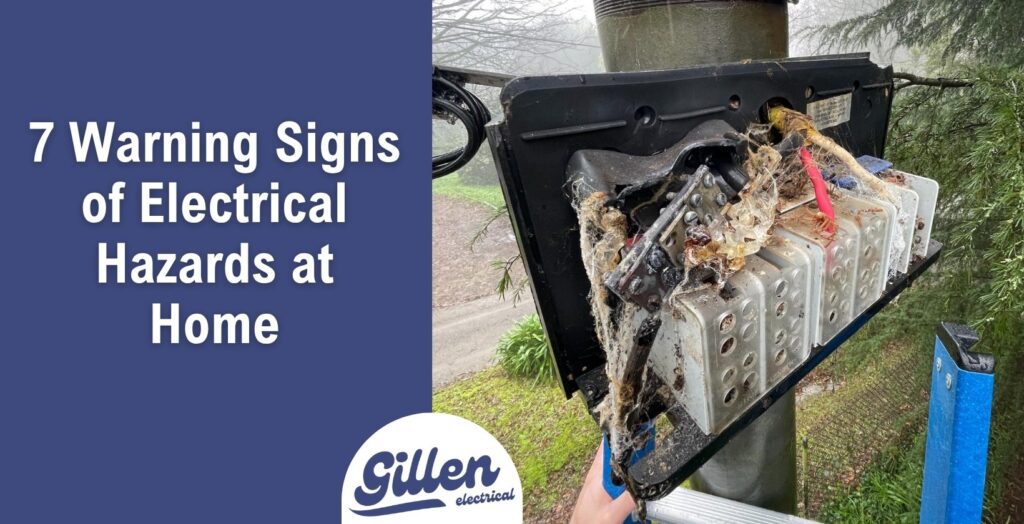The 7 warning signs of electrical hazards at home are poor wiring, burning smells, overloaded powerboards, wet outlets, loose or discoloured sockets, buzzing noises, and daisy-chained cords. Any experienced residential electrician knows that each of these problems increases the risk of shock, fire, or failure if ignored.
In this blog, we’ll discuss the 7 warning signs of electrical hazards and what steps you have to take to make your home safe.
7 Electrical Safety Warning Signs to Know
Here are the 7 electrical safety warning signs any homeowner should know:
1. Faulty or Damaged Wiring
Old or poorly installed wiring creates dangerous conditions behind walls and ceilings. Frayed insulation, exposed copper, or cracked conduits allow arcing and can cause overheating.
One sign of an electrical wiring problem is when your safety switch keeps tripping after using certain appliances. Wiring faults often link to overloaded circuits or poor connections behind switches and outlets.
Licenced electricians identify these issues during inspections and test for compliance with current standards. Repairs must include rewiring sections or replacing cable runs that fall short of today’s safety codes.
2. Burnt Smell from Outlets
A burnt odour around switches or sockets points to overheating inside the wall cavity. This often comes from high resistance in old wires or a loose connection, generating excess heat.
These smells usually worsen when multiple appliances are running from the same point. Never ignore this – a smouldering wire can quickly escalate to flame.
You have to cut power at the switchboard and call an electrician immediately. Leaving it live risks fire, especially in older homes with timber framing.
3. Overloaded Powerboards
Too many devices running off one powerboard will strain the circuit beyond safe capacity. This overloading triggers breakers or melts internal plastic if ignored.
The most common overload setups involve daisy-chained powerboards or high-wattage appliances grouped together. Hairdryers, heaters, and microwaves each draw heavy current and need their own outlet.
Using powerboards with built-in overload protection adds one layer of defence. Still, if a powerboard gets warm or trips regularly, it needs replacing.
4. Wet or Damp Outlets
Moisture and electricity form a deadly mix, especially in bathrooms, kitchens, or outdoor areas. A damp power point can short circuit or cause electrocution when touched.
Look for signs of condensation, corrosion, or bubbling paint near any outlet. These indicators often appear before the outlet fails or gives a zap.
Sealing gaps and using weatherproof covers helps prevent this issue. GPOs near sinks or outdoor zones must be rated and installed with care.
5. Loose or Discoloured Outlets
Movement in a power point creates intermittent connections that lead to sparking behind the plate. This sparking causes browning, melting, or deformation of the outlet’s face.
Discolouration signals heat damage from long-term arcing or current leakage. If the wall around the switch looks singed, the internal wiring has already started to fail.
Outlets must sit firmly flush with the wall and stay cool under normal load to avoid accidents. Any wobble, crack, or heat build-up in the outlets means replacement is required.
6. Buzzing or Crackling Noises
Any buzzing, clicking, or crackling sounds near an electrical outlet show arcing or loose connections. These noises become more pronounced under load or when using appliances.
Unlike the general hum from a fridge or fan, electrical buzz indicates internal faults. Leave it unattended, and the arc can melt insulation or ignite dust.
You should always shut down the circuit and book a professional for testing. Faults like buzzing or crackling noises can escalate quickly and are the main fire starters in homes.
7. Unsafe Extension Cord Setups
Connecting multiple cords builds resistance and increases fire risk. Daisy-chaining also leads to uneven load distribution across circuits.
Many people run heaters or air conditioners this way, not realising how much current they pull. Overheating and melted plugs are common outcomes in these setups.
Each heavy-load appliance needs a direct outlet or dedicated circuit. If multiple cords seem “necessary,” you likely need additional power points installed.

